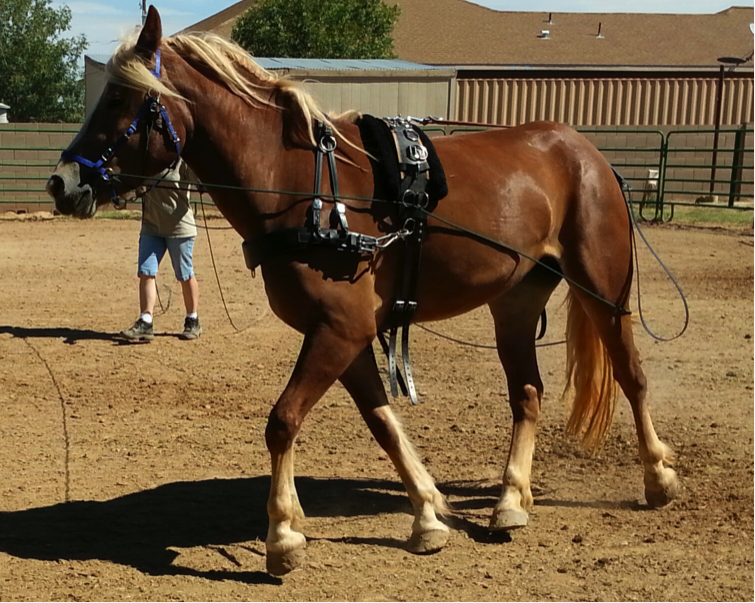Basic Groundwork Training
Safety is essential in training the driving horse, both for the driver and for the horse.
Safe training involves two things, being sure the horse fully understands and is prepared for each step of training and having safeguards built-in, just in case.
One of the things I emphasize with my students is this:
“It is not that the horse would do something; it is that the horse could do something.“
In this series, I will cover important safety points in each stage of training the driving horse, from basic groundwork to hitching for the first time so that you can have increased success and less risk of an accident while working with your horses.
- Part one: Basic groundwork
- Part two: Introducing draft
- Part three: The drag
- Part four: Preparation for and hitching the first time
Basic groundwork
The basic groundwork for driving horses must teach the horse how to yield to pressure, whether from the whip, reins, traces, shafts, pole, or the handler’s hands and body.
The basics training includes:
- ·yielding the shoulders and the hips
- ·Lunges nicely in all three gaits (walk, trot, canter)
- ·Long lining in all three gaits
·and most importantly, to halt and stand until told to do otherwise. Especially important because a driving horse must reliably stand still while being harnessed and hooked, and unhooked from a vehicle.
Holding the lines safely
There are a few points to consider when working the horse from the ground.
Any time you have a line in your hand attached to the horse, you want to be sure that it is folded across your hand instead of looped around it.
If the line is looped around your hand, you can’t drop the line should the horse pull away or even stumble. As the horse pulls, the coils tighten around the hand, and you run the risk of being jerked off your feet or, if a loop happens to get around a finger, losing a finger. I like to wear gloves as it gives me extra grip and protection should something happen, and it is much easier to buy a new pair of gloves than to grow back layers of skin!
If you don’t want to carry the extra line in your hand, it should be tossed out straight behind you and well out of the way. If it ends up coiled under your feet, there is the chance of getting your legs tangled in it and being tripped up and possibly dragged.





Yielding
Yielding the hips and shoulders in-hand is used to introduce the horse to the whip aids so that the horse can understand that the whip means “move sideways” and not just “move faster.” Once the horse does it well yielding away from the handler it should learn to move the hip and shoulder towards the handler. If your goal is to both ride and drive your horse, this becomes very useful in teaching the horse to step up beside a mounting block or another object so you can swing aboard.
Lungeing teaches the horse basic voice aids and how to be responsible for its movements. It also helps to build strength and balance. Lungeing sessions should be reasonably short to avoid repetitive stress on the joints. I work the horse long enough to be sure it is listening and build on the previous sessions.
Long lining
Before long lining for the first time, you should introduce your horse to the bridle they will be using. Practice in-hand flexions so that the horse understands how to give to the rein pressure.
Then, using a single line, wrap it across the horse’s hip and ask it to yield to the contact and turn and face you. This action gets the horse used to responding to the outside rein and having the line across the hips.
When long lining the horse should be fitted with its bridle and at least a lungeing surcingle. A saddle can work as well if you tie the stirrups together under the belly and run the lines through them. If you use a full driving harness, run the lines through the shaft loops to prevent the horse from twisting underneath them and getting the lines tangled around the terrets.
Ideally, the outside line should stay above the horse’s hocks on turns and circles. Direction changes are always made away from the driver. If direction changes are made at the trot, the driver may need to jog to keep up, and one should get the horse used to someone jogging beside and behind them before trying it on the long lines. Some horses might get frightened by someone suddenly chasing after them, even if it is only for a few steps, so be sure to prepare your horse for that by jogging in hand or running a couple of steps while lungeing before you do it with the long lines.
Once the horse is going well on the long lines in the walk, trot, and canter, you can prepare for the next stage of training: Introducing Draft.
Check out part 2 in the next issue of the Journal

This article first appears in the EA Journal in February 2022 – Get your free copy







